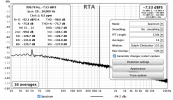I was wondering how to set and interpret distortion in the RTA window of REW. Below is one measurement of a phono stage. Clearly one can see 50 Hz noise around -95 dB. However, the N figure is at -75 dB. How is the noise (N) calculated? Is this what should be expected? I can't really see how the graph and distortion figures compares to e.g. Amirs measurements here:

 www.audiosciencereview.com
www.audiosciencereview.com


Cambridge Audio Duo Phono Stage Review (Updated)
This is an updated review of the Cambridge Audio Duo phono preamplifier. It is on kind loan from a member and costs US $349. The Duo has a solid build and is attractive to boot for its price. Back panel shows independent sets of inputs for moving magnet and coil cartridges: I like the...
 www.audiosciencereview.com
www.audiosciencereview.com
